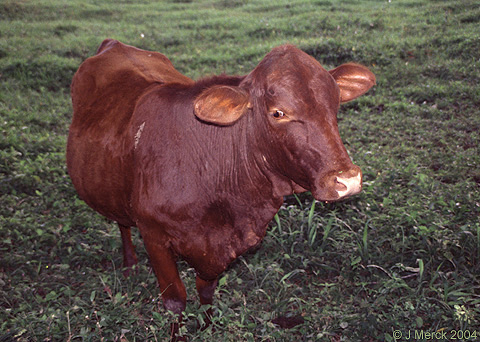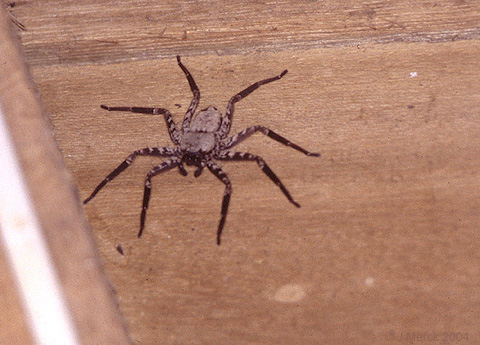Phylogenetic Systematics: Evolutionary Patterns
The diversity of living things presents us with a seemingly infinite variety. The science of systematics is dedicted to identifying and ordering the diversity of living things.
Systematics: The ordering of this diversity. Since prehistory, systematists have employed taxonomic systems in which organisms are classified into groups or taxa (singular: taxon). Many different taxonomic systems are conceivable, but all have the following features:
- A heirarchy of internested groups
- An organizational principle.
 For example, in our lives, we have all employed the taxonomic system in which animals are classified according to the organizational principle of their utility to humans. Generally, there is little ambiguity.
For example, in our lives, we have all employed the taxonomic system in which animals are classified according to the organizational principle of their utility to humans. Generally, there is little ambiguity.
Livestock |
Pet
|
Vermin |

Green tree python, Morelia viridis
The Linnaean System: The first attempt to organize the diversity of life in an explicit and non-arbitrary manner was made by Carl Linnaeus (a.k.a. Carolus Linnaeus and, after his ennoblement, Carl von Linné.) Linnaeus was a Swedish botanist who may be the first and last person in history to publish on every known organism. His Systema Naturae is the basis for the Linnaean system of taxonomy. Its first edition was in 1735, but the tenth is regarded as the most authoritative, published in 1758. Its major features:
- Systematized and popularized the use of the binomial nomenclature first proposed by the Bauhin brothers in 1596.
- Organisms grouped according to physical similarity of key features. Linnaeus had pioneered the classification of plants based on reproductive structures, which he considered the least ambiguous, and applied this concept to animals, as well. By this means, whales were moved from fish to mammals, and humans were placed among the primates.
- Groups formed an internested hierarchy. A groups position in the hierarchy was expressed as its taxonomic rank. Expanded subsequently into the familiar kingdom, phylum, class, order, family, genus, species.

The Linnaean System in the age of Darwin: The recognition that Linnaean taxa were products of shared common ancestry provoked refinements of the system such that only groups that shared common ancestry were acknowledged. Thus, "Pachydermata" containing rhinos, elephants, and hippos, but not their common ancestor, was out. Beyond that, before the age of digital computers and electronic media, not much else was really practical. The result was an awkward century in which the Linnaean system was used and interpreted in an evolutionary sense, but where certain infelicities were tolerated.
- Conflation of true extinctions and pseudoextinctions: Any serious attempt to assess lineage longevity (e.g. Van Valen's Red Queen hypothesis) or identify mass extinction events absolutely needed to factor pseudoextinctions out, but this was usually impractical.
- The biological unreality of taxonomic ranks: Cosider this example: How are alligators like oysters? - Both the groups Alligatoridae, including modern alligators and caimans, and Ostreidae, containing modern oysters, have the rank of "family" in the Linnean system, suggesting that they are somehow biologically equivalent. Many measures of equivalence can be imagined.
- Maybe the progenitors of Ostreidae and Alligatoridae lived at the same time in the geologic past.
- Maybe the two groups include the same number of species.
- Maybe they encompass the same degree of morphological divergence.
But alas...
- Ostreidae: appears in Late Triassic (about 210 mya). Alligatoridae: appears in Paleocene (about 60 mya).
- There are considerably more ostreid species (39 fossil) than alligatorid (26 fossil).
- Ostreidae and Alligatoridae are so different that an objective standard of morphological similarity can't be envisioned.
So what, exactly, does it mean to say that oysters and alligators are related at the "family" level? Can it be that establishing taxonomic rank is, "more of an art than a science," involving the interpolation of new groups into the preexisting system?
That's OK if you only intend to use the system for information retrieval, but academics who attempt to measure patterns of evolution by counting, say, families inevitably must confront the fact that they really are not counting equivalent units. Stephen Jay Gould famously fell for this in his influential book Wonderful Life.
Ideally, we would like to have some non-arbitrary, natural organizing principle for a taxonomic system that natural scientists can use. Indeed, Darwin, in the Origin noted that the Linnean system of taxonomy, based on general similarity, ought to be superceded by one based on closeness of common ancestry. Alas, on a practical level, such an undertaking was impossible until the invention of digital computers.
- Numerical taxonomy (Phenetics): Introduced by Robert Sokal and Peter Sneath in late 1950s. Attempted to base classification on similarity alone, viewing the tree of evolution as fundamentally unknowable. Often called Phenetics. Pheneticists tend to use continuous numerical measurements in multivariate statistical analyses to identify groups.
- Phylogenetic Systematics (Cladistics): Introduced by Willi Hennig in 1950. His book Phylogenetic Systematics was translated into English in 1966. Viewed evolution as the indispensable organising principle of biology and the basis for a taxonomic system. Also called Cladistics. Cladists tend to use characters with discrete states and parsimony-based analyses (or in recent years, Bayesian analyses based on a priori models of evolution) to reconstruct the Tree. From this, they take their taxonomic system.
By the mid 1970s, cladistics had eclipsed phenetics. By the 90s it was the dominant school of taxonomic thought. In North America, the 1980s were the heady era of taxonomic revolution in which cladistic revolutionaries in institutions such as the University of California at Berkeley and the American Museum of Natural History shaped the future of systematics. A revealing document from this era is Kevin DeQueiroz', 1988. Systematics and the Darwinian Revolution.
DeQueiroz 1988's key concepts:
- Homology vs. Analogy
- Homology: Derivation of structures in different individuals from the same evolutionary precursor. E.G. Human arms, bird wings, whale flippers - all derived from the ancestral tetrapod forelimb.
- Analogy: Similarity of function without any necessary common derivation. E.G. Dragonfly wings and bird wings - used in flying but with no common derivation.
- Class vs. Individual
- Class: A group consisting of entities defined by their characteristics. (E.G. "electrons," "tax-collectors")
- System (or "individual"): A group consisting of entities defined by their historical origin and fate.
- Classification vs. System
- Classification: Taxonomy based on a hierarchy of classes.
- Systematics: Taxonomy based on a hierarchy of individuals related by an organizing principle.
Cladobabble: Terminology and Conventions of Phylogenetic Systematics
The triumph of phylogenetic systematics sets the tone for contemporary academic discussions of phylogeny and systematics. This requires the well-informed reader to master graphic conventions and some rather clunky technical terms. You can do it.Cladograms: Throughout evolutionary history, lineages of interbreeding organisms have evolved through time and occasionally split into separate, reproductively isolated lineages. The result is an evolutionary "tree" with many branches. We represent this tree, or portions of it that we want to talk about, using stick-figure trees called cladograms.


Note that in a cladogram, it does not matter whether things appear on the left or right. What counts is the sequence of branching events (i.e. which ones appear on top or on the bottom). In the figure above, cladograms 1 and 2 depict exactly the same relationships, whereas cladogram 3 is different.
 The phylogenetic taxonomic system: Taxonomic groups can be named and defined based on their descent from a common ancestor. The cladogram below shows the real relationships between several major vertebrate groups.
The phylogenetic taxonomic system: Taxonomic groups can be named and defined based on their descent from a common ancestor. The cladogram below shows the real relationships between several major vertebrate groups.
Working from this cladogram, systematists have named the following taxonomic groups:


In this drawing, we have drawn circles around the groups that could be defined by the relationships shown on this cladogram, and indicated their names. Ordinarily, one would simply write the group names next to the node of the last common ancestor:
Thus, the pattern of evolution provides:
- A hierarchy of internested groups, with those descended from more recent common ancestors being nested within those descended from more distant ones. For instance, "Tetrapoda", the common ancestor of land vertebrates and its descendants, is nested within "Choanata", the common ancestor of vertebrates with choanae and all of its descendants.
- An organizing principle, the branching pattern of evolution itself.
Definitions:
Monophyletic groups: In phylogenetic systematics, taxonomic groups are defined strictly in terms of the non-arbitrary criterion of descent from a common ancestor. Such taxa are called monophyletic groups.
-
Memorize this definition: A monophyletic group is an ancestor and ALL of its descendants.
- Paraphyletic groups: An ancestor and some but not all of its descendants.
- Polyphyletic groups: A group of organisms which fails to include at least some of their common ancestors.
Note: You may be familiar with two types of non-monophyletic groups:
Note carefully: Only monophyletic groups are based exclusively on natural, non-arbitrary criteria. When we define a paraphyletic group, we must arbitrarily decide which descendants to exclude. In the case of polyphyletic groups, we must decide which ancestors to leave out.
Phylogeny reconstruction using parsimony






